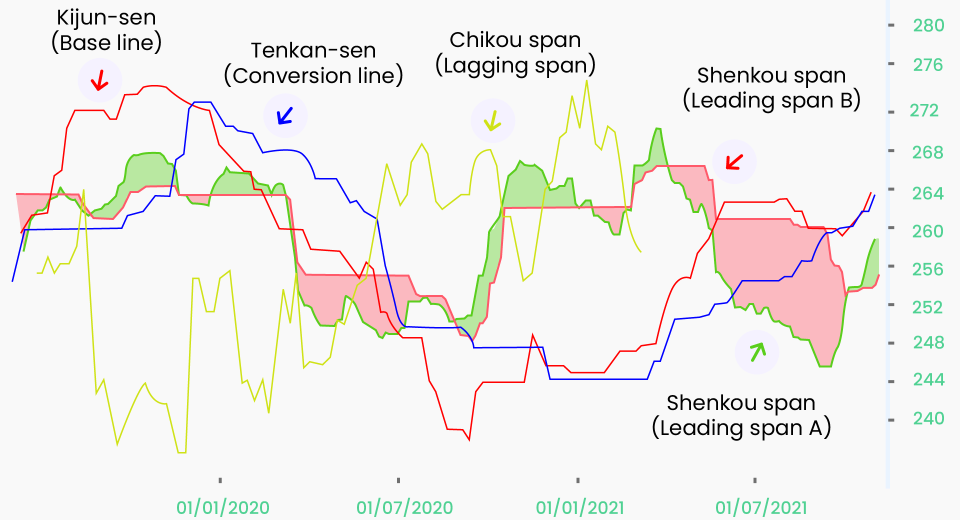MACD Trading Basics: How to Identify Entry and Exits?

The moving averages convergence divergence (MACD) indicator is popular among traders because it presents a comprehensive view of the market in an easy-to-read manner. This guide to trading MACD will help you learn to identify the entry and exit points using the indicator.
Fundamentals of MACD
The MACD appears below the price movement chart. The various components of the indicator drawn using an asset’s price movement history are:
MACD Line
The MACD line is the difference between the 12-day EMA (Exponential Moving Average) and the 26-day EMA.
MACD line = 12-day EMA − 26-day EMA
Signal Line
The signal line is the 9-day EMA of the MACD line.
Signal line = 9-day EMA of MACD
Histogram
The MACD histogram represents the difference between the MACD line and the signal line. It is drawn on the baseline (0) and functions like an oscillator.
Histogram = MACD line – Signal line
Another popular way of plotting the MACD is using the 12-day and 48-day EMAs. Here, the signal line is the 10-day EMA of the MACD line.
MACD Trading Strategies
The most important trading technique while using MACD is to confirm its signals with another indicator, since it is prone to whipsaws.
Trading MACD Crossovers
Two types of crossovers are used when trading MACD – one with the signal line and the other with the centreline (baseline).
MACD – Signal Line Crossover
A bullish crossover occurs when the MACD line crosses over above the signal line, while the histogram is below the baseline. This is also known as a Golden Cross and is considered a signal to take a long position.
Conservative traders often wait for the MACD to cross above the 0-line to confirm the signal. This emphasises that while using an oscillator, traders tend to act on the signal only if the price chart and the oscillator are in agreement.
On the other hand, a bearish crossover occurs when the MACD line crosses below the signal line and the crossover takes place above 0. This is a signal to open a short trade and is also known as a Death Cross.
In both scenarios, the length of the histogram bars acts as a metric for signal strength. The longer the bar, the stronger the signal.
MACD – Baseline Crossover
These crossovers are strong trend reversal signals and are indicated by the transition of the histogram from one side to another of the centreline. Although these crossovers may last for multiple periods, the ones at the inflection points are considered the strongest indicators.
When the MACD becomes negative (crosses below the centreline), it is a bearish zero crossover, signalling strength in the downward momentum and vice versa.
Trading MACD Divergence
In trending markets with high volatility, traders popularly use MACD divergence as an indicator of a trend reversal. MACD divergence occurs when the price action separates from the indicator.
An example of MACD divergence is when the price is making consecutively lower lows and the histogram is making higher lows. This is known as a momentum decline, foreshadowing a bearish divergence.
Experienced traders average up their short trades (exit their short positions) when the price reverses at the final point of divergence to take advantage of the opportunity.
Closing Positions with the MACD Indicator
Traders commonly exit their positions when the MACD crosses over in the opposite direction of the ongoing trend at the time of opening a trade. For instance, if a trader entered at a Golden Cross, they could exit when the MACD line crosses below the signal line.
Combining MACD with Other Indicators
Most popularly, MACD is paired with indicators such as resistance and support levels and candlestick patterns to confirm signals.
MACD with RSI
Support-Resistance indicators, such as the Relative Strength Index (RSI) can help identify potential reversals and breakout points.
For example, an MACD divergence when the price indicates an overbought (RSI is below 30) or oversold (RSI is over 70) market lends weight to speculations of a price reversal.
MACD with Candlestick Reversals
Many Japanese candlestick patterns indicate that the price trend is about to reverse. These include the Evening Star and Bearish Engulfing patterns, after a sustained uptrend, and the Morning Star and Bullish Engulfing patterns, after a downtrend. They provide a strong indication of market reversal when the MACD divergence occurs simultaneously.
MACD with Stochastic Oscillators
The Stochastic Oscillator and MACD form an effective combination because the former compares an asset’s closing price to its price range over a given timeframe, while the latter analyses convergence and divergence of moving averages of the price.
A bullish crossover of the MACD and signal line when the histogram is above the centreline, along with a bullish stochastic divergence (%K crossing %D from below provided both values are under 80), is considered a strong signal of a bullish trend reversal. Traders use it to take long positions.
Advantages and Disadvantages of Using the MACD Indicator
- MACD takes into consideration the comprehensive picture and not just the current price.
- It is highly adaptable, since EMA durations can be set by traders according to their trading strategy.
- MACD can be used to gauge both the trend and the momentum of the price action.
- It is drawn below the price charts, which makes combining other indicators convenient.
- MACD is very helpful in markets with high volatility.
The MACD indicator has a few shortcomings too:
- It is ineffective in range-bound markets.
- It cannot predict overbought and oversold market conditions.
- It overlooks smaller trading opportunities and can only help discover the larger ones.
To Sum Up
- MACD is a lagging trading indicator that represents comprehensive market information in a compact manner.
- It uses exponential moving averages of different durations as the MACD line and the signal line.
- The convergence and/or divergence of any two MACD lines, signal lines, and baseline can signal potential entry/exit points.
- MACD signals are usually confirmed using another indicator, since it could give false signals.
- In general, the most widely used trading signal is the MACD crossing over the signal line in the direction of the trend.
- MACD can be combined with other indicators, such as RSI, Stochastic Oscillator and candlestick patterns to form a powerful trading strategy.
Disclaimer:
All data, information and materials are published and provided “as is” solely for informational purposes only, and is not intended nor should be considered, in any way, as investment advice, recommendations, and/or suggestions for performing any actions with financial instruments. The information and opinions presented do not take into account any particular individual’s investment objectives, financial situation or needs, and hence does not constitute as an advice or a recommendation with respect to any investment product. All investors should seek advice from certified financial advisors based on their unique situation before making any investment decisions in accordance to their personal risk appetite. Blackwell Global endeavours to ensure that the information provided is complete and correct, but make no representation as to the actuality, accuracy or completeness of the information. Information, data and opinions may change without notice and Blackwell Global is not obliged to update on the changes. The opinions and views expressed are solely those of the authors and analysts and do not necessarily represent that of Blackwell Global or its management, shareholders, and affiliates. Any projections or views of the market provided may not prove to be accurate. Past performance is not necessarily an indicative of future performance. Blackwell Global assumes no liability for any loss arising directly or indirectly from use of or reliance on such information herein contained. Reproduction of this information, in whole or in part, is not permitted.




